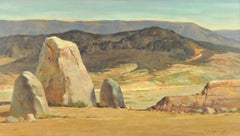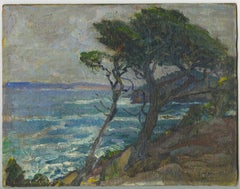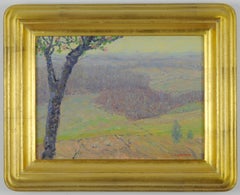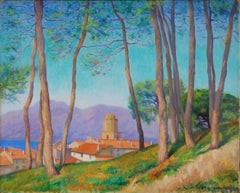Want more images or videos?
Request additional images or videos from the seller
1 of 6
William John EdmondsonPoint Lobos, Californiac. 1925
c. 1925
$7,500List Price
About the Item
- Creator:William John Edmondson (1868-1966, American)
- Creation Year:c. 1925
- Dimensions:Height: 10.5 in (26.67 cm)Width: 13.5 in (34.29 cm)
- Medium:
- Period:
- Condition:Frame: Period McBeth Gallery style frame.
- Gallery Location:Fairlawn, OH
- Reference Number:Seller: FA86111stDibs: G130708140177
About the Seller
5.0
Recognized Seller
These prestigious sellers are industry leaders and represent the highest echelon for item quality and design.
Platinum Seller
Premium sellers with a 4.7+ rating and 24-hour response times
Established in 1978
1stDibs seller since 2013
819 sales on 1stDibs
Associations
International Fine Print Dealers Association
Authenticity Guarantee
In the unlikely event there’s an issue with an item’s authenticity, contact us within 1 year for a full refund. DetailsMoney-Back Guarantee
If your item is not as described, is damaged in transit, or does not arrive, contact us within 7 days for a full refund. Details24-Hour Cancellation
You have a 24-hour grace period in which to reconsider your purchase, with no questions asked.Vetted Professional Sellers
Our world-class sellers must adhere to strict standards for service and quality, maintaining the integrity of our listings.Price-Match Guarantee
If you find that a seller listed the same item for a lower price elsewhere, we’ll match it.Trusted Global Delivery
Our best-in-class carrier network provides specialized shipping options worldwide, including custom delivery.You May Also Like
Landscape - XXI century, Contemporary Oil & Acrylic Painting, Abstraction
By Monika Rossa
Located in Warsaw, PL
MONIKA ROSSA
studied painting at the University of Arizona, in the Ecole des Beaux Arts in Paris and at the Escuela de Diseno in Barcelona. She practices drawing and easel painting....
Category
21st Century and Contemporary Abstract Abstract Paintings
Materials
Oil, Acrylic, Board
$884
H 14.97 in W 24.02 in
The Old Mill, British Landscape and Waterfall, 19th Century
Located in Hillsborough, NC
The Old Mill is a 19th century oil painting on board by Scottish artist Colin Hunter, (1841-1904). Hunter was a member of the Royal Academy with the title...
Category
19th Century Naturalistic Landscape Paintings
Materials
Oil, Board
$1,960 Sale Price
20% Off
H 30 in W 35 in D 2.5 in
Three Dutch ships on rough seas, 17th Century, oil on board
Located in Hillsborough, NC
Dutch School, 17th century oil painting on board, this work features a golden ship on blue seas with white crests against a stormy clouded sky. In the distance more ships can be seen, and a spot of blue sky gives the stormy clouds relief. Light shines through the white clouds casting shadows of color on the gray storm and choppy sea waters. Dramatic and masterful.
Presented in overall very good condition in what may be the original mahogany wood frame.
Excellent for an office, library, den or study, but can also be effective in a living room, dining room or bedroom.
The frame has a rich wood tone. Easy to ship and ready to hang.
Check out our Saltire Gallerie...
Category
17th Century Dutch School Landscape Paintings
Materials
Oil, Board
$3,200
H 20 in W 21 in D 1.5 in
Italian Landscape, Ariccia and The Alban Mountains - Oil on Paper 1850´s
Located in Stockholm, SE
View of the Ariccia Bridge and the Alban Hills
This finely executed plein air landscape depicts the monumental bridge of Ariccia and the town with the surrounding Alban Hills, painted by German landscape artist Joachim Ludwig Heinrich Daniel Bünsow (born 1821 in Kiel, died 1910 in the same city). Executed in oil on paper mounted on cardboard, the work dates from his Italian period between 1853 and 1858. Not signed.
Bünsow received his artistic training at the Royal Danish Academy of Fine Arts in Copenhagen from 1839 to 1848, studying under Johann Ludwig Lund and Christoffer Wilhelm Eckersberg. In 1844, the Copenhagen Art Association acquired his painting "Tellingstedt in Dithmarschen." Following his studies, he traveled to Dresden, where he became associated with the circle around Johan Christian Dahl. A scholarship from the Copenhagen Academy enabled Bünsow to reside in Rome from 1853 to 1858. During this period, his landscapes evolved from the finely toned, naturalistic style of his early work to more atmospheric and idealized compositions, influenced by Louis Gurlitt.
Bünsow's early works from his time in Copenhagen are characterized by fine tonality and naturalistic rendering, reflecting the style of his teacher Christoffer Wilhelm Eckersberg. His Italian landscapes, however, exhibit a more atmospheric and idealized approach, influenced by Louis Gurlitt. Notably, Bünsow produced high-quality drawings during his time in Rome, some of which are preserved in the Kunsthalle zu Kiel.
Historical Context: The Ariccia Bridge
In the early 19th century, the local authorities sought to improve the Appian Way's safety and accessibility. The solution involved constructing bridges to span the Ariccia valley and adjacent ravines. In 1843, Pope Gregory XVI commissioned a six-arched bridge to address the elevation differences. Following his death in 1846, Pope Pius IX continued the project, entrusting architect Ireneo Aleandri with the design and Giuseppe Bertolini with the execution.
Completed in 1854, the bridge stands as a significant 19th-century engineering achievement. Featuring three tiers of elegant neoclassical arches inspired by Roman art, it measures 59 meters in height and 312 meters in length. Travertine columns at both ends commemorate the Roman milestones...
Category
1850s Other Art Style Landscape Paintings
Materials
Paper, Oil, Cardboard
$5,663
Free Shipping
H 11.23 in W 17.33 in D 1.19 in
Woodstock: Field with Trees in Hilly Landscape
Located in Philadelphia, PA
William S. Butz
(American, active Woodstock, N.Y., 1911-39)
Field with Trees in Hilly Landscape
Oil on canvasboard, 8 3/4 x 11 inches
Framed: 15 x 17 inches (approx.)
Signed on verso...
Category
1920s Realist Landscape Paintings
Materials
Oil, Board
Stephen Stallings "May 1st" 1975 Signed Rural Americana Landscape Painting
Located in Miami, FL
STEPHEN STALLINGS – "MAY 1ST"
⚜ Mixed Media on Board ⚜ Hand Signed, Dated, and Titled Lower Right; Signed Verso ⚜ Conservation Frame
DETAILED AMERICAN LANDSCAPE
Painted in 1975, Ste...
Category
1970s American Realist Landscape Paintings
Materials
Oil, Board
$2,600
H 16.125 in W 20.125 in D 1 in
Stephen Stallings "An Everlasting Mystery" 1973 Signed Coastal Pier Painting
Located in Miami, FL
STEPHEN STALLINGS – "AN EVERLASTING MYSTERY"
⚜ Mixed Media on Board ⚜ Hand Signed and Titled Lower Right; Signed Verso with Fingerprint ⚜ Conservation Frame
MYSTICAL COASTAL SCENE
P...
Category
1970s American Realist Landscape Paintings
Materials
Oil, Board
$2,600
H 16.125 in W 20.125 in D 1 in
Oil on board View of Mount Grappa and Boccaor, T. Wolf Ferrari - 1934, Italy
Located in Vicenza, VI
Oil on panel by Teodoro Wolf ferrari executed in 1934 measuring 23.5x16 cm.
The most investigated theme is landscape. The motionless, rarefied atmospheres, accompanied by the play of...
Category
1930s Other Art Style Landscape Paintings
Materials
Oil, Board
$1,179
H 6.3 in W 9.26 in D 0.2 in
Spanish river landscape oil on board painting
Located in Sitges, Barcelona
Rosendo González Carbonell (1910-1984) - River landscape
Oil on panel - Hand signed
Oil measures 27x35 cm.
Frame measures 49x57 cm.
Painter of the first half of the 20th century, bo...
Category
1970s Post-Impressionist Landscape Paintings
Materials
Oil, Board
$331 Sale Price
49% Off
H 10.63 in W 13.78 in
Beach with dunes oil paint on board seascape
By Alberto Biesok
Located in Sitges, Barcelona
Born in Valencia but with German and Mediterranean roots, his artistic work has been focused on exhibitions around the idea of "landscape", within a formal pictorial and drawing po...
Category
2010s Realist Landscape Paintings
Materials
Board, Oil
$497 Sale Price
57% Off
H 5.91 in W 15.75 in
More From This Seller
View AllBlue Horizon (near Sante Fe, New Mexico)
By Elmer Ladislaw Novotny
Located in Fairlawn, OH
Blue Horizon (Near Sante Fe, New Mexico)
Signed by the artist lower right (see photo)
Oil on board, 16 x 27 5/8 inches
Condition: Very good. Housed in the or...
Category
1970s Realist Paintings
Materials
Oil, Board
Point Lobos, California
By William John Edmondson
Located in Fairlawn, OH
Point Lobos, California
Oil on artist's board, c. 1925
Signed lower right: Wm J Edmundson (see photo)
Condition: Very good condition
Frame: Period McBeth Gallery style frame (see pho...
Category
1920s American Impressionist Landscape Paintings
Materials
Oil
Spring in Brown County
By Louis Oscar Griffith
Located in Fairlawn, OH
Spring in Brown County
Oil on canvas mounted on phenolic resin support, c. 1925
Signed lower right: L. O. Griffith (see photo)
Condition: Excellent
Painting size: 10 x 13 3/4 inches
...
Category
1920s American Impressionist Landscape Paintings
Materials
Oil
The Port of San Tropez
By Alexander L. Warshawsky
Located in Fairlawn, OH
The Port of San Tropez
Oil on canvas, c. 1920
Signed lower right corner (see photo)
Condition: Excellent, professionally cleaned
Image/Canvas size: 25 3/4 x 32 inches
Frame size: 30...
Category
1920s American Impressionist Landscape Paintings
Materials
Oil
untitled (French Townscape with Clouds and Mountains)
By William S. Gisch
Located in Fairlawn, OH
untitled (French Townscape with Clouds and Mountains)
Oil on masonite
Signed with the estate stamp verso (see photo)
Hand painted frame by the artist. (see photos)
Image eize: 24 x 2...
Category
1930s American Impressionist Landscape Paintings
Materials
Oil
Storms (At Sea)
By Louis Oscar Griffith
Located in Fairlawn, OH
Storm (At Sea)
Oil on board, c. 1908
Signed: L. O. Griffith lower left (see photo)
Titled on label verso
Image: 6 5/8 x 8 3/4"
Frame: 10 x 12 x 1 1/2"
Provenance: Estate of the Arti...
Category
Early 1900s American Impressionist Landscape Paintings
Materials
Oil



